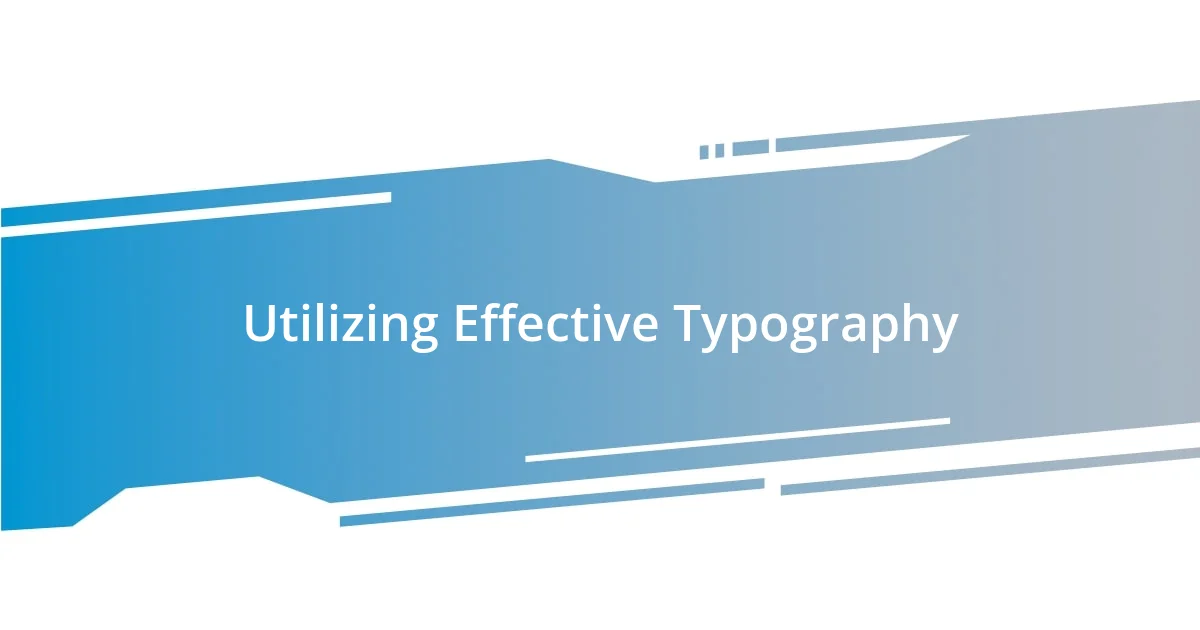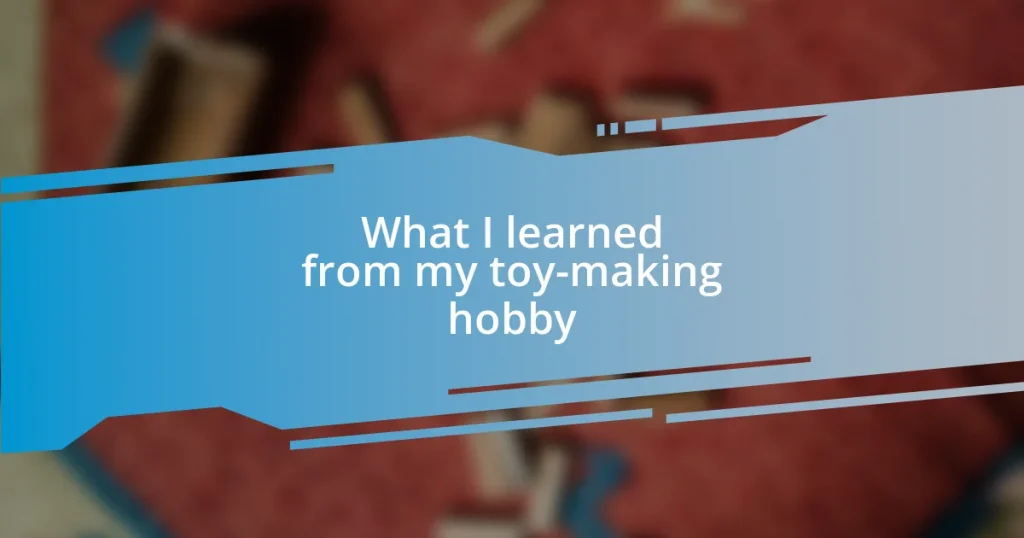Key takeaways:
- Choosing poster themes that resonate with the content and evoke emotions enhances viewer engagement and clarity of message.
- Effective color selection and typography significantly influence perception and readability, impacting the emotional response and overall message delivery.
- Testing designs and gathering feedback from diverse audiences is essential for improvement, ensuring clarity and effectiveness in communication.

Understanding Poster Themes
When I first started exploring poster themes, I quickly realized how crucial it is to choose designs that resonate with the content. Have you ever been drawn in by a poster because of its color scheme or layout? I recall creating a poster for a community event, and the vibrant colors I used truly captured the essence of the gathering, making people stop and look.
Understanding the essence of poster themes goes beyond visuals; it’s about creating a narrative that engages viewers. I remember a time when I used a minimalist theme for a scientific concept I was presenting. The simplicity allowed my audience to focus on the core message without distractions. It’s fascinating how a carefully crafted theme can evoke emotions and clarify intentions, isn’t it?
Themes can also serve as a unifying thread that ties together various elements of your poster. I once designed a series of posters for a workshop series, and by using a consistent theme, I was able to create a cohesive experience for attendees. It made the whole concept feel more professional and inviting, and I definitely learned that themes are the unsung heroes of impactful posters.

Choosing the Right Colors
Choosing the right colors for your poster is more than just picking shades that look good together; it’s about conveying the right message. I remember working on a health awareness poster, where I opted for calming blues and vibrant greens. These colors not only signified tranquility but also represented nature, making the message of wellness resonate deeply with viewers.
Color psychology plays a significant role in how people perceive information. For example, warm colors like red and orange can evoke excitement and urgency, while cooler tones like blue promote calmness and reliability. In my experience, when I chose a bold red for a fundraiser event poster, it attracted attention and heightened the sense of importance around the cause. It’s interesting how colors can influence emotions and actions, isn’t it?
When selecting colors, it’s essential to consider your audience as well. For instance, when I designed a poster for an academic conference, I opted for muted and professional hues like navy and gray, which instilled a sense of trust and authority. In contrast, a poster aimed at children would benefit from brighter, playful colors to engage their interest. It’s incredible how a thoughtful color palette can enhance the overall impact of your message.
| Color | Emotion/Meaning |
|---|---|
| Blue | Calmness, Trust |
| Red | Excitement, Urgency |
| Green | Nature, Wellness |
| Gray | Neutrality, Authority |
| Yellow | Optimism, Energy |

Creating Engaging Layouts
Creating an engaging layout for your poster transcends mere aesthetics; it’s about guiding the viewer’s eye and delivering your message effectively. I learned this firsthand when designing a poster for a local art exhibition. By incorporating a zigzag flow, I led viewers seamlessly from one section to another, making the experience feel like a journey. It was rewarding to see how such a simple layout could enhance engagement and spark curiosity.
Here are some elements that have helped me craft captivating layouts:
- Hierarchy of Information: Use size and placement to prioritize key messages. Larger fonts draw attention while supporting details can be smaller.
- White Space: Don’t be afraid to embrace white space; it can make content less overwhelming and more digestible.
- Visual Balance: Distribute images and text evenly across the poster to create harmony and prevent clutter.
- Visual Cues: Arrows or lines can guide the viewer’s eye through the layout, making the information flow logical.
- Consistent Alignment: Maintain uniform margins and alignment to instill professionalism and maintain focus on the content.
Another time, while crafting a poster for a workshop, I used a grid system that kept everything organized and visually appealing. Participants appreciated how easy it was to find information. Layouts can truly enhance comprehension and retention, often making the difference between a poster that’s simply seen and one that resonates with the audience.

Incorporating Visual Elements
Incorporating striking visual elements into your posters can dramatically elevate their impact. I once experimented with the use of infographics in a poster for a community health initiative. The combination of simple icons, statistics, and short texts created a visual storytelling effect. It felt rewarding to see how this approach made complex data accessible and engaging for everyone who passed by.
Images play a crucial role as well, acting as focal points that draw viewers in. I remember adding a powerful photograph to a poster focused on environmental conservation. The image of a pristine forest captured immediate attention and stirred emotions, prompting conversations and interest about the message behind it. Don’t you think visual storytelling can often convey feelings that words alone sometimes struggle to communicate?
Integrating various visual elements, like graphs or charts, also helps in conveying critical data clearly. For instance, when I designed a poster for a science fair, I included a pie chart representing data succinctly, which really resonated with the analytical crowd. It’s fascinating how well-structured visuals can simplify information, enhancing retention and understanding among your audience.

Utilizing Effective Typography
Utilizing Effective Typography
When it comes to typography, I’ve always believed that the right font can make or break a poster. I learned this the hard way during a university project where I opted for a trendy, cursive font that I thought looked artistic. However, feedback showed that many couldn’t read my main points clearly. It was a humbling experience that underscored the importance of readability over style. Wouldn’t you agree that clarity should always take precedence?
I often choose sans-serif fonts for body text due to their clean lines. This choice reflects my experience that they are much easier on the eyes, especially from a distance. Last year, for a poster I created for a charity event, using a bold sans-serif typeface not only improved clarity but also made the text stand out against a colorful backdrop. It was gratifying to see attendees engaged and easily reading all the information, which reinforced my commitment to effective typography.
Another thing I like to consider is the contrast between my text and background. During a workshop presentation, I once used dark text on a light background, creating a visually appealing and highly legible piece. Mixing this with the concept of hierarchy, I ensured that the most crucial bits of information were large and bold, guiding eyes where I wanted them to go right away. Isn’t it interesting how these small changes can have such a significant impact on information delivery and viewer experience?

Making the Message Clear
Making your message clear is the cornerstone of effective poster design. I vividly remember a project where I had to convey complex research findings in a community health poster. Initially, I packed it with too much information, which left viewers confused rather than enlightened. It wasn’t until I simplified the content, focusing on just three key points, that I noticed people actually stopped to read and engage with my message. Isn’t it amazing how less can be so much more?
The use of bullet points can be particularly beneficial in maintaining clarity. I once created a poster for an educational seminar and structured the information using clear bullet points to highlight important takeaways. This not only made the content digestible but also helped my audience retain the most crucial details. I could see the shift in engagement; people were nodding along and jotting notes as they absorbed the key points with ease. Have you ever experienced that “aha” moment when someone finally grasps a complicated idea through straightforward communication?
Finally, choosing the right words is just as important as how you present them visually. I recall drafting slogans for a series of environmental posters. The struggle was real—finding the perfect blend of brevity and impact required thoughtful consideration. Ultimately, using active verbs and concrete nouns transformed my messages, elevating them from mundane to compelling. Isn’t it rewarding when you find the precise words that resonate with your audience and drive your message home?

Testing and Getting Feedback
Testing your poster and getting feedback before finalizing it is a crucial step that I’ve learned can make all the difference. During one of my early projects, I thought my layout was perfect, but after sharing it with peers, their honest critiques highlighted an overcrowded design that distracted from my message. Initially, it stung to hear, but in retrospect, I’m grateful for those insights, as they helped me pivot my approach for future designs.
In my experience, providing a draft to diverse viewers can reveal unexpected perspectives. When I submitted a poster prototype to a mixed group of students and faculty, the varying interpretations of my visuals were eye-opening. I was surprised to learn that some found certain elements engaging, while others felt confused by the imagery. That’s when it clicked for me—what makes sense to one person may not translate to others. Isn’t it fascinating how different backgrounds can influence perception?
I’m always reminded of how critical it is to iterate based on feedback. Once, I presented a new poster concept at a local art exhibit. After some lively discussions with fellow artists, I realized I needed to adjust my color scheme to enhance visual appeal. Those little tweaks, inspired by honest dialogue, transformed the piece from “meh” to captivating. Have you ever implemented feedback that completely changed your project for the better? It’s a thrilling journey that reminds me how valuable collaboration can be in the creative process.
















